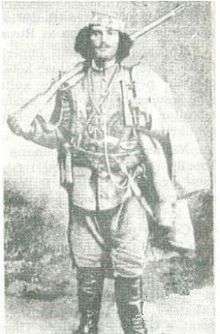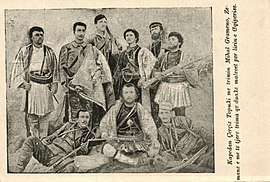Çerçiz Topulli
| Çerçiz Topulli | |
|---|---|
 Çerçiz Topulli in a rare photo | |
| Born |
20 September 1880 Gjirokastër, Albania (then Janina Vilayet, Ottoman Empire) |
| Died |
15 July 1915 (aged 35) Shkoder, Albania |
| Occupation | Freedom Fighter, Rilindas (Revivalists) |
| Period | 1907 - 1915 |
| Literary movement | Albanian National Revival |
| Notable awards | People's Hero of Albania |
Çerçiz Topulli (1880 - 15 July 1915) was a patriotic Albanian nationalist figure and guerrilla fighter. He was the younger brother of Bajo Topulli.[1] He was known for fighting the Ottomans in 1907 and 1908 and then after they left, the Greeks in 1913 and 1914 during the Balkan Wars.[2]
Biography
Armed resistance
During early 1906, he and his brother Bajo founded the first Albanian armed guerrilla band.[3] The group was active for three years, with both brothers taking a winter break during 1906-1907 and spending it in Sofia and Bucharest.[4][3] Both brothers had been professionals who decided to engage in guerilla warfare after leaving the comforts of town life.[3] The guerilla band viewed the Ottoman regime of Abdul Hamid II along with Greeks and Slavs as the enemy.[3]
In the spring of 1907, he and Mihal Grameno formed a band of guerrillas in Sofia to fight for Albanian interests.[5][6] In April of that year, the band landed in Vlora,[5] having entered the country from Brindisi. The purpose was to spread Albanian national consciousness among the people, including the immediate need for administrative autonomy for Albanians within the Ottoman Empire.[5][6] They also brought books in Albanian for the people.[5] He wrote an article "From the Mountains of Albania" in the journal "The Hope of Albania" in its issue. In that article he condemned the many thefts that the Turkish administration would commit towards the Albanians and asked for full independence of Albania. In the article he made calls for an armed insurgency.[1] Soon campaigns of agitation were prepared so as to lead an armed uprising in 1908.[5][6]
The armed bands of Çerçiz Topulli cooperated and were on good terms with armed groups of Bulgarian-Macedonian revolutionaries operating in the Lake Prespa region and Kastoria area, a bond formed due to their hostility toward Greeks.[5]
On 25 February 1908, Çerçiz and his followers had assassinated the Ottoman Binbaşı (Lieutenant Colonel) of Gjirokastër,[7][8] who had brutally suppressed those Albanians working for Albanian political ends.[5] Five of them, including Çerçiz Topulli, then fled to Mashkullorë, a village near the town of Gjirokastër. On March 18 they were surrounded in Mashkullorë by Ottoman forces[9][5] from Ioannina.[7] The Ottoman force of 150 troops vastly outnumbered Çerçiz's kachaks.[6] However, Topulli and his fighters managed to keep the Ottomans at bay[5] from dawn until dusk and then fled into the mountains, an event which was later celebrated in folk ballads.[6]
During the Young Turk Revolution (1908), Ahmed Niyazi Bey devoted his energies toward recruiting Çerçiz whom he regarded as "the Chief of the Tosk Committee of Albanians".[10] At the behest of the Young Turks (CUP), the Albanian committee of Korçë called on Albanian guerillas to join Ottoman insurgent bands.[11] The Albanian committee of Ohrid followed through with guerilla leaders Çerçiz Topulli and Mihal Grameno meeting Niyazi Bey at Resen on July 23 with promises that a Ottoman constitution would be advantageous for the Albanian nation.[11] Baba Hysejn, head of a Bektashi tekke in the Korçë region also played a role in influencing Çerçiz and other Albanian leaders to support the CUP and restore the constitution.[12] In July 1908, Topulli attempted to take the town of Korçë, but his forces were pushed back by Ottoman troops. When the Ottoman Young Turks took power, he organized patriotic societies and assisted in the opening of Albanian-language schools.[6] During the Ottoman countercoup of 1909, among the 15,000 volunteers assisting the larger Ottoman army Topulli along with Bajram Curri mobilized 8,000 Albanians that put down the revolt in Istanbul.[13]
On 29 May 1909, Çerçiz Topulli founded in Gjirokastër a secret society called Kandilja (The Candle), an underground çeta group.[14]
After independence

After the proclamation of the independence of Albania on November 28, 1912 Topulli was also active in the defense of national interests after independence. Albanian bands under the command of Çerçiz Topulli and his cohort composed of fifty people, Albanians and Bulgarians against the Greek bands. Adjutant-Major Ahmed Niyazi Bey too stated that in Ohrid, Bulgarian bands and Albanian Tosk bands under Çerçiz Topulli had been united.[15]
Topulli went to the north to help with the efforts against Montenegrin forces. He was killed in the Fusha e Shtoit (Shkodër) from the Montenegrin invaders.
Quotes
Çerçiz Topulli subordinated religious differences and every other consideration to this goal of national liberation:
- "Each Mohammedan has a duty to die for a Christian because he is blood of his blood; in the same way each Christian should die for a Mohammedan who is likewise blood of his own blood[14]"
Topulli was a strong advocate against the Ottomans:
- "We go with rifle in hand, out into the mountains, to seek freedom, justice, civilization and progress for all ... to expel the Turks from our dear Motherland[14]"
References
- 1 2 http://www.gazeta-albania.net/news.php?id=2771
- ↑ Frances Trix, The Sufi journey of Baba Rexheb, University of Pennsylvania Press, 2009.
- 1 2 3 4 Gawrych 2006, p. 147.
- ↑ Skendi 1967, p. 210.
- 1 2 3 4 5 6 7 8 9 Skendi 1967, p. 210-212.
- 1 2 3 4 5 6 Elsie, Robert. Historical Dictionary of Albania.
- 1 2 Haid, Gerlinde. European Voices: Multipart Singing in the Balkans and the Mediterranean, Volume 1.
- ↑ http://forumishqiptar.com/showthread.php?t=91914
- ↑ Gawrych 2006, p. 148.
- ↑ Gawrych 2006, p. 150.
- 1 2 Skendi, Stavro (1967). The Albanian national awakening. Princeton: Princeton University Press. pp. 340–341. ISBN 9781400847761.
- ↑ Gawrych 2006, p. 151.
- ↑ Gawrych, George (2006). The Crescent and the Eagle: Ottoman rule, Islam and the Albanians, 1874–1913. London: IB Tauris. p. 167. ISBN 9781845112875.
- 1 2 3 Jacques, Edwin E. (1995). The Albanians: An Ethnic History from Prehistoric Times to the Present. McFarland.
- ↑ Hanioglu, Sukru. Preparation for a Revolution: The Young Turks, 1902-1908.
- ↑ http://korcajone.net/forum/showthread.php?t=1831
- ↑ sq:Çerçiz Topulli